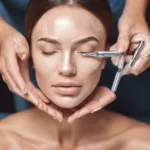27 November 2023
A comprehensive guide to the benefits, risks, and procedure of dermaplaning
Dermaplaning, a popular minimally invasive procedure, is gaining attention for its ability to reveal brighter, smoother skin by shaving away the top layers. This article explores the world of dermaplaning, including its benefits, risks, and the steps involved in the procedure. Whether you’re looking to reduce the appearance of acne scars, exfoliate dull skin, or remove unwanted hair, dermaplaning offers a promising solution.
What is Dermaplaning?
Dermaplaning involves using a handheld surgical device called a dermatome to gently shave off thin layers of skin and hair. This deep exfoliating method can be performed on specific problem areas or the entire face, depending on individual needs. It is often used to reduce the appearance of fine lines, wrinkles, and acne scars.
Dermaplaning vs. Dermabrasion vs. Microdermabrasion: What’s the Difference?
While dermaplaning, dermabrasion, and microdermabrasion are all methods of removing the top layers of skin, they differ in terms of tools used and the depth of exfoliation. Microdermabrasion involves spraying microcrystals or using a diamond-tipped device, while dermabrasion uses an electric rotating brush. Dermaplaning, on the other hand, employs a scalpel-like dermatome for deeper exfoliation.
Benefits of Dermaplaning
Dermaplaning offers a range of potential benefits, including reducing the appearance of fine lines, minimizing acne scars and pitted skin, brightening dull and dry skin, removing unwanted vellus hair, improving skin texture, treating sun-damaged skin, allowing for deeper absorption of skincare products, and prepping the skin for other treatments or surgical procedures.
Who is Dermaplaning Right For?
Dermaplaning is suitable for almost anyone looking to improve the texture and appearance of their skin. Individuals with sun-damaged skin, signs of aging, or certain skin conditions like rosacea may find dermaplaning beneficial. However, those with active acne breakouts, cold sores, skin rashes, burns, or moles should avoid the procedure.
What Happens Before, During, and After Dermaplaning?
Before a dermaplaning appointment, a consultation will take place to discuss goals and potential risks. Patients may be asked to cleanse their face and avoid certain medications. During the procedure, a numbing cream or anesthesia may be applied, and the dermatome is used to carefully remove the top layers of skin. Afterward, skincare products may be applied, and visible results can be seen immediately. Temporary redness or sensitivity may occur, which typically fades within three months.
What Are the Risks of Dermaplaning?
While dermaplaning is generally safe, there are a few potential risks, including scarring, nicks and cuts, fever blisters, skin irritation, and thickened skin. These risks are relatively rare, and the procedure is considered safe and effective when performed by a trained professional.
Do You Need Multiple Dermaplaning Procedures?
Dermaplaning results are not permanent, and the effects may last for several weeks before hair regrowth occurs. To maintain ongoing improvements in skin texture and appearance, many people opt for monthly dermaplaning sessions.
Conclusion:
Dermaplaning offers a promising solution for individuals seeking brighter, smoother skin. With its ability to reduce the appearance of acne scars, exfoliate dull skin, and remove unwanted hair, dermaplaning has become a popular choice for many. While there are potential risks involved, the procedure is generally safe and effective when performed by a trained professional. If you’re considering dermaplaning, consult with a dermatologist to determine if it’s the right option for you.



